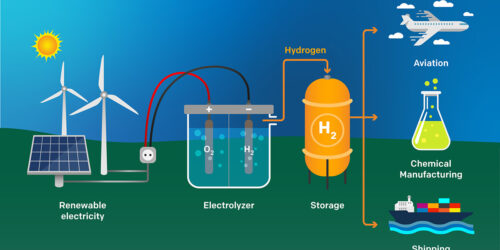Less than 1% of hydrogen today is produced using renewable energy. “Green hydrogen” is made using 100% renewable electricity to split hydrogen from water molecules. For now, this is the only established way to produce hydrogen without emitting climate or air pollution.
For hydrogen to have a role in our clean energy future, the first priority should be deploying green hydrogen to displace the millions of metric tons of dirty hydrogen that the United States already makes from fossil fuels each year. The limited supply of green hydrogen may also help transition to renewable energy in specific sectors like shipping, aviation, high-heat industrial processes, and long-distance trucking.
Hydrogen Shouldn’t Be Used in Homes and Buildings to Replace “Natural” Gas
The report explores whether hydrogen can be used to replace fossil fuels for heating and cooking in homes and buildings, which is responsible for a tenth of the United States’ climate pollution and produces health-harming indoor air pollution to boot.
Hydrogen is a false solution for this sector because:
- Electric appliances would be more energy efficient, improve air quality, and avoid the risks of leaking hydrogen, which is both the smallest molecule in the universe and a potent greenhouse gas.
- Injecting hydrogen in appreciable volumes would create safety hazards in our pipelines and household appliances.
- If a gas company used as much green hydrogen as optimistically possible, it would only reduce the climate impact of burning the company’s gas by about 7%.
Similarly, because battery electric vehicles are significantly more energy efficient and cheaper than hydrogen vehicles, green hydrogen would be wasted in the vast majority of cars, buses, and trucks.TANJA GEIS FOR EARTHJUSTICEComparing the efficiency of renewable energy in battery and fuel cell vehicles.
Policymakers and legislators should be wary of hype around hydrogen. When deployed as a marketing tool by the fossil fuel industry, hydrogen can be used to hinder necessary climate action, like the transition to electric appliances in homes and buildings and the shift to battery electric vehicles. Electrifying our transportation systems and buildings and running them on a renewable energy grid is key to solving both our air quality and climate pollution problems.
Most Hydrogen Uses Today Are an Environmental Justice Problem
CLIMATE COSTSGlobally, hydrogen production is responsible for more greenhouse gas emissions than the entire country of Germany.
The report illustrates how the latest wave of hype masks the fact that most hydrogen production today pollutes communities and drives climate breakdown. The fossil fuel industry is both the United States’ largest producer and consumer of hydrogen, with roughly 60% of the nation’s domestic supply deployed in crude oil refining with significant environmental justice impacts. Globally, hydrogen production is responsible for more greenhouse gas emissions than the entire country of Germany.
Communities near oil refineries bear the brunt of this pollution because hydrogen production most often takes place at refineries. The report additionally finds that the fossil fuel industry is using vague and unproven promises about the potential to retrofit polluting gas power-plants — which are disproportionately located in communities of color — to justify the construction of new gas power plants and to keep existing plants open.
If gas-power plants were to be retrofitted to run on hydrogen, the air pollution impacts in frontline communities could be even more devastating. One group of researchers predicted that burning pure hydrogen would emit more than six times as much NOx as burning methane, the main component in fossil gas.







